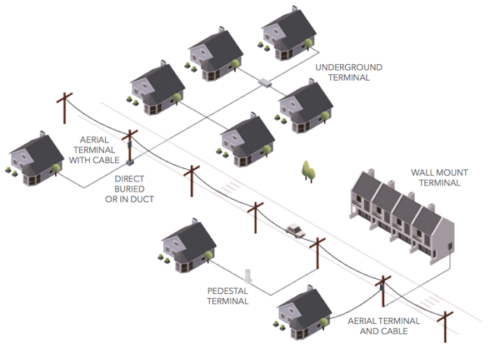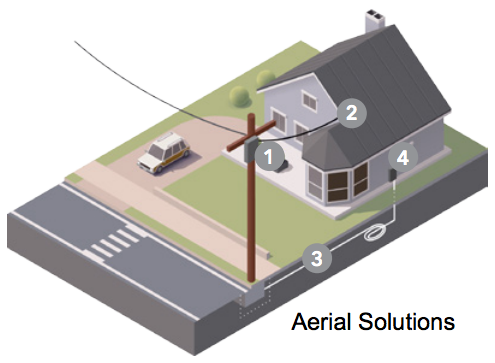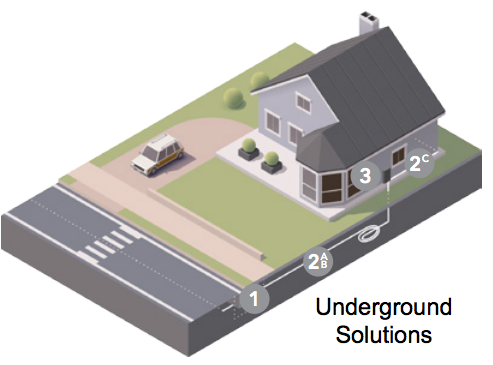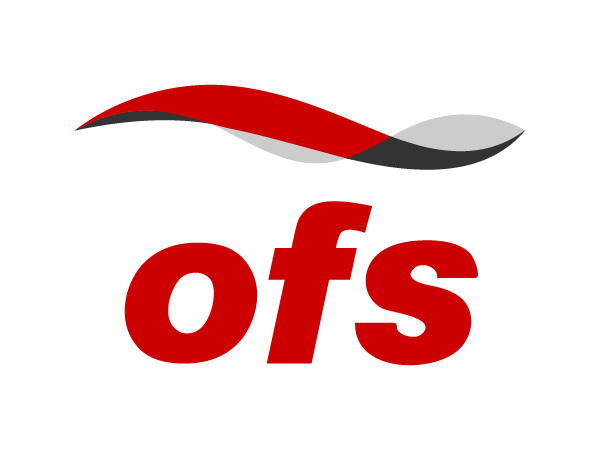
Fiber to the Home (FTTH) is becoming increasingly more common as bandwidth usage is exploding. This tremendous growth is driven in part by the rapid increase in Internet-connected devices and the use of data-heavy applications such as video on demand. Service providers are working to meet this need for greater bandwidth by expanding the deployment of fiber optic cables to the premises and then into the home.
Service providers building these fiber networks all face a common challenge: the expense of the last mile in the optical network. It is critical for service providers, utilities and municipalities to have an optimized set of deployment options that help to reduce both capital and operational expenses.
The solutions presented in this article meet these challenges with several fiber deployment options from the drop point to and into the home.
OFS FTTx Solutions for the Home can help residents take advantage of the Internet of Things (IoT), which is beginning to redefine how we work and live. These solutions focus on simplicity, cost-effectiveness and speed of installation, along with the pre- and post-installation customer experience, time to revenue generation and reliable subscriber connections that help to improve profitability for the service provider.
>> Download the Full Guide Now
PRE-TERMINATED vs. FIELD-TERMINATED DROPS
Pre-terminated drop solutions are increasingly used to install fiber to homes to save time and money in higher labor cost regions. Pre-terminated drop solutions consist of drop cables that are terminated and tested in the factory, and easily plugged into the drop terminal and home terminal in the field. Pre-terminated solutions offer lower costs and faster deployment and require less installation skill.
For low labor cost markets, field terminated solutions may be preferred. Field terminated solutions use drop cables which are terminated using fusion splicing or mechanical connectors in the field during installation. They offer easier inventory management, lower material costs and easier slack management, but take longer to install and require more highly skilled labor, along with expensive field termination tools and splicing machines, when compared to pre-terminated solutions.
A third approach, with one end of the drop cable pre-terminated, and the other end field terminated, can solve the slack issue and allow an easy plug-in to the drop terminal and field termination at the home.
OFS offers all three of these drop solution options to fit the unique needs of each service provider. OFS pre-terminated solutions are available with EZ- Bend® cables that can solve the slack management challenge. EZ-Bend fiber optic cables enable the slack to be tied into a very compact bundle.
Providers typically use a combination of aerial and underground solutions to connect the last mile in a network to individual homes. A variety of factors including climate and existing infrastructure can influence solution selection.
>> Download the Full Guide Now
CONNECTING OPTICAL FIBER TO THE HOME
OFS offers a complete portfolio of aerial and underground solutions including terminals, integrated splitters and drop cables to connect to the demarcation point of individual homes. From that location, a number of solutions can be leveraged to take optical fiber into the home.
 Aerial deployment is typically lower in cost and preferred where poles are in place near homes. In this scenario, a SlimBox® Drop Terminal is installed on a pole, with or without splitters, and then connected by a drop cable to as many as 16 homes. Below grade drop deployment is preferred if there is an existing duct placed from the terminal location to the home, or if below grade cabling is required by local regulations.
Aerial deployment is typically lower in cost and preferred where poles are in place near homes. In this scenario, a SlimBox® Drop Terminal is installed on a pole, with or without splitters, and then connected by a drop cable to as many as 16 homes. Below grade drop deployment is preferred if there is an existing duct placed from the terminal location to the home, or if below grade cabling is required by local regulations.
First, an installer inserts a feeder or distribution cable into the terminal. The installer then extracts the number of fibers required and fusion splices them to a pre-terminated splitter or drop fiber. Aerial or underground drop cables are then deployed from the terminal to individual residences.
In the case of aerial cables, a drop cable is placed between the pole and a point near a home’s roof. The cable can be connected to a demarcation box and installed into the home through the attic or onto the side of the house at a demarcation box near the ground. To help avoid unsightly aerial cables, an aerial terminal can be connected to an underground drop cable. For aerial deployments, OFS offers the one to 24-fiber Mini LT Flat Drop Cable and the single-fiber Mini TB Flat Drop cable which contains 3 mm cordage that can be routed directly to an Optical Network Terminal (ONT).
>> Download the Full Guide Now
 Underground drop cable options include the single-fiber EZ-Bend® 3.0 mm and 4.8 mm Ruggedized Cables and EZ-Bend Toneable Cables. The toneable cables enable easy above ground locating of buried cables to help avoid cable cuts when other underground systems are installed. These drop cables are installed from the aerial terminal down the pole to the ground, and are then buried to minimize disruption to landscaping, or pulled into existing duct. The cable is then connected into a demarcation box installed at the side of the house, ideally in a location close to the ONT on the inside.
Underground drop cable options include the single-fiber EZ-Bend® 3.0 mm and 4.8 mm Ruggedized Cables and EZ-Bend Toneable Cables. The toneable cables enable easy above ground locating of buried cables to help avoid cable cuts when other underground systems are installed. These drop cables are installed from the aerial terminal down the pole to the ground, and are then buried to minimize disruption to landscaping, or pulled into existing duct. The cable is then connected into a demarcation box installed at the side of the house, ideally in a location close to the ONT on the inside.
EZ-Bend cables are preferred since their 2.5 mm bend radius allows the cables to be coiled, bent and tied without creating signal degradation. These cables can also be buried or stapled/clipped and bent around the outer perimeter walls of a home to reach an entry point closer to the preferred ONT location.
New home construction offers a win-win situation for construction companies and service providers. With the ability to “build in” optical fiber connectivity, new homes are futureproofed from the beginning, real estate values increase, and new home owners can become immediate subscribers without the expense of additional installation time. .
Subscribers can be connected faster using preterminated cables installed to and into homes during construction. OFS offers EZ-Bend 3.0 mm and 4.8 mm cables that can be installed independently or in ducts using typical home wiring techniques, such as stapling or zip-tying of the cables, to a location or media panel where the ONT would be later placed. The home owner can later perform a “self install” by receiving an ONT from the service provider, and simply plugging in an EZ-Bend cable assembly and a power adapter to the ONT. OFS also provides a SlimBox Wall Plate that discretely blends into a home’s décor and facilitates ONT connections in the same way as a power outlet.
Existing Homes can pose a challenge to network installers, given the wide variety of possible building architectures. In addition, home designs and construction materials can vary greatly from country to country and even within countries. OFS solutions are purposefully designed and optimized to suit a variety of homes globally and offer maximum flexibility to on-site installers.
Depending on the target market, a provider can choose the terminals and drop cables for an aerial, underground or hybrid solution. The solutions described are the most popular options and feature a variety of products as building block components. This modular product design approach allows service providers to also create custom solutions to meet the specific needs of their target markets.
>> Download the Full Guide Now

